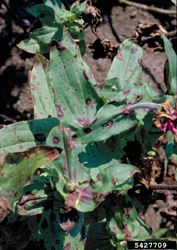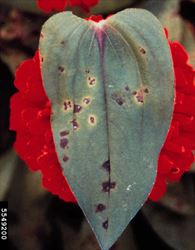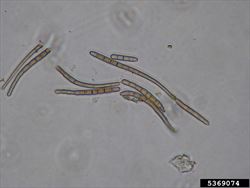- Cercospora leaf spot: widespread. In Oceania, common. Alternaria blight: moderately widespread world distribution, but not Africa. In Oceania, Tonga.
- Symptoms:
- Cercospora: circular to irregular spots, up to 5mm diameter, light-grey to white centres, reddish borders, merging. Leaves wither and die. Spots on flowers.
- Alternaria: initially circular spots, becoming irregular, up to 10mm; reddish-brown with light-grey centres (which may fall out); merging. Leaves wither and die. Stems with spots – severe at nodes, killing stems and causing dieback; possibly, cankers on stems at soil level. Spots on flowers. Sunflower is an alternative host.
- Spread: spores in wind-blown rain. Alternaria with seed.
- Biocontrol: none.
- Biosecurity: risk is from seedborne infections of Alternaria.
- Cultural control: hot-water treatment of seed (for Alternaria infection) – 51oC for 20 minutes; avoid new plantings next to (or downwind from) older infected plants, or where zinnias planted previously; space plants (allowing air movement), avoid planting in shade; do not give overhead water; collect burn or bury dead plants.
- Chemical control: protectants - copper, mancozeb, chlorothalonil; systemic products – e.g., strobolins or sterol biosynthesis inhibitors (follow manufactures’ recommendations).
Pacific Pests, Pathogens and Weeds - Online edition
Pacific Pests, Pathogens, Weeds & Pesticides
Zinnia leaf spots (532)
Zinnia leaf spots; two similar leaf spots occur: one is caused by the fungus Cercospora, and is called Cercospora leaf spot, the other is caused by the fungus Alternaria, and is called Alternaria blight. CABI prefers the name 'leaf spot of sunflower' for the latter.
Cercospora zinniae and Alternaria zinniae.
AUTHOR Grahame Jackson
Information from CABI (2019) Alternaria zinniae (leaf spot of zinnia). Crop Protection Compendium. (https://www.cabi.org/cpc/datasheet/4536); and CABI (2019) Cercospora zinniae. Crop Protection Compendium. (https://www.cabi.org/cpc/datasheet/12298); and Alternaria blight of Zinnia. Missouri Botanic Garden (https://www.missouribotanicalgarden.org/gardens-gardening/your-garden/help-for-the-home-gardener/advice-tips-resources/pests-and-problems/diseases/fungal-spots/alternaria-blight.aspx); and Zinnia-Alternaria blight. Pacific Northwest. Pest Management Handbooks. (https://pnwhandbooks.org/plantdisease/host-disease/zinnia-alternaria-blight); and Zinnia insect pests & diseases (2022) Home & Garden Information Center. Clemson University Cooperative Extension Service. (https://hgic.clemson.edu/factsheet/zinnia-insect-pests-diseases/); and Common leaf diseases of zinnia (1987) Department of Crop Science. University of Illinois Extension. (http://ipm.illinois.edu/diseases/rpds/655.pdf); and Phengsintham P, et al. (2013) Monograph of Cercosporoid fungi from Loas. Current Research in Environmental & Applied Mycology 3(1): 34-158. (https://creamjournal.org/pdf/Cream_3_1_2.pdf). Photo 3 Larry Osborne, Bugwood.org. Photo 4 John Hartman, University of Kentucky, Bugwood.org. Photo 5 Penn State Department of Plant Pathology & Environmental Microbiology Archives, Penn State University, Bugwood.org. Photo 6 Paul Bachi, University of Kentucky Research and Education Center, Bugwood.org. Photo 7. Bruce Watt, University of Maine, Bugwood.org.
Produced with support from the Australian Centre for International Agricultural Research under project HORT/2016/185: Responding to emerging pest and disease threats to horticulture in the Pacific islands, implemented by the University of Queensland, in association with the Pacific Community.










